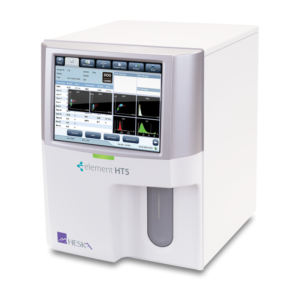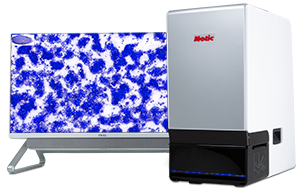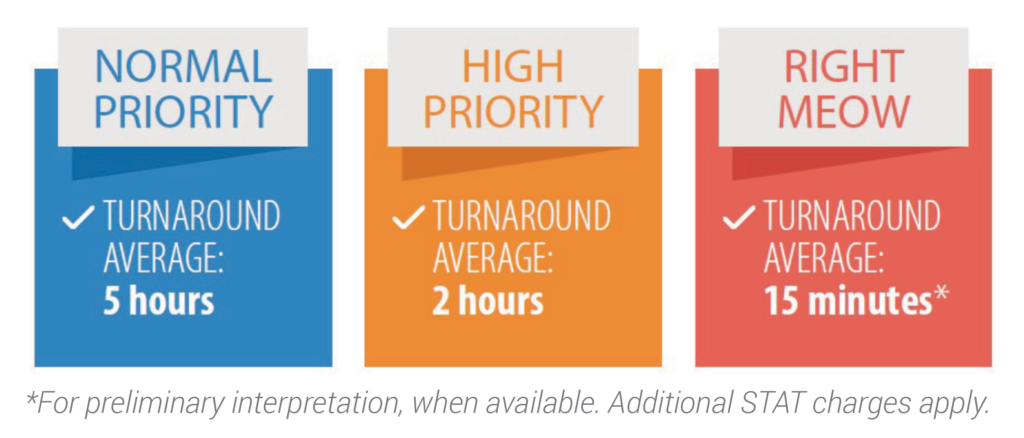Hematology in the Point-of-Care Lab
DOWNLOAD this article
Hematology studies provide information vital to the diagnosis of illness in sick animals and give insights into the well-being of pets during annual wellness checks. The Complete Blood Count (CBC) includes assessment of red blood cells, white blood cells, and platelets and is one of the core parameters of the minimum database when evaluating any pet. It’s no secret that preventative care improves quality of life and increases longevity in our veterinary patients, and in 2010 the American Veterinary Medical Association included ‘prevention of disease’ in the veterinary oath1. The minimum database should be performed during wellness appointments annually. For geriatric pets and those patients with pre-existing conditions, the minimum database should be performed semi-annually, or more frequently depending on their specific medical condition. With two-thirds of dog breeds having at least one recognized genetic disorder, routine screening provides a means for early detection of disease processes1. The minimum database provides a framework for consistent standards and improves diagnostic efficiency2. Early detection of disease allows for monitoring and intervention which can delay or even prevent critical illness. Normal findings are important to document as they provide a baseline for that patient.
The minimum database may include, but is not limited to:
- Complete Blood Count (CBC)
- Serum biochemistry profile
- Urinalysis
- Fecal screening
- Heartworm testing
- +/- T4 screening
- +/- Retroviral testing
- +/- Blood pressure screening
- +/- Electrocardiography
- +/- FNA/cytology
- +/- Radiographs
AUTOMATED HEMATOLOGY ANALYZERS
 Complete blood counts are typically performed using an automated analyzer in either the point-of-care or reference laboratory setting. Technology that is now available in the point-of-care setting rivals that used in reference laboratory analyzers. Both types of analyzers generate the most critical results: 5-part WBC differential, HGB, HCT, PLT and more. Reference laboratory analyzers are often capable of advanced parameters which can provide additional insights. Point-of-care hematology allows for immediate results leading to rapid diagnosis and patient treatment.
Complete blood counts are typically performed using an automated analyzer in either the point-of-care or reference laboratory setting. Technology that is now available in the point-of-care setting rivals that used in reference laboratory analyzers. Both types of analyzers generate the most critical results: 5-part WBC differential, HGB, HCT, PLT and more. Reference laboratory analyzers are often capable of advanced parameters which can provide additional insights. Point-of-care hematology allows for immediate results leading to rapid diagnosis and patient treatment.
CBC Microscopy
Although a multitude of parameters can be assayed by hematology analyzers, manual blood smears must also be evaluated to confirm the automated results in both the point-of-care and reference laboratory setting. Evaluation of the blood smear allows for the confirmation of the WBC count and differential, determination of the presence or absence of toxic change in neutrophils, assessment of RBC morphology, and identification of inclusions or parasites. Microscopy is an essential part of a quality CBC result, whether performed in your practice or by an outside reference laboratory.
WHEN SHOULD A PATHOLOGIST REVIEW OF A BLOOD SMEAR BE ORDERED?
Any case with hematological abnormalities or risk factors associated with hematologic diseases where a whole blood sample is available should be evaluated microscopically in-clinic. Ideally, these samples would also be interpreted by veterinary pathologists or other specialists, as a baseline CBC with pathologist review are critical tools to aid in determining the cause of anemia, assessing smears for abnormal leukocytes and screening for hematological parasites or infectious disease agents.
What goes into a CBC with Pathologist Review at the Reference Laboratory? Once received at the reference lab, whole blood samples stored in EDTA tubes are run on automated hematology analyzers, similar to the process in the point-of-care setting. Blood films are also prepared for manual differential and morphologic review. However, in the past decade there has been a shift to digitizing blood smears for easier storage and viewing. Most reference laboratories will now prepare and digitize the blood film immediately upon intake.
 POINT OF CARE PATHOLOGY
POINT OF CARE PATHOLOGY
Traditionally, pathologists could only evaluate blood films from samples physically sent to the reference laboratory. However, in recent years digital slide scanning has given veterinary professionals the option of point-of-care CBC pathologist review via remote consultation with board certified veterinary clinical pathologists. Studies have shown digital cytologic evaluation is similarly adequate in diagnosing disease when compared to the traditional glass slide process3. Advances in digital telecytology allow the review of blood films and other cytological samples by a clinical pathologist at the point-of-care setting, similar to the reference laboratory process, but in real time!
Veterinary professionals in private practice can wield the power of digital pathology without the typical wait times associated with physical transfer of samples to a reference lab. The dramatically reduced turnaround times provided by digital telecytology will undoubtedly improve patient outcomes and owner compliance. Start diagnosing at the speed of digital and bring a pathologist into your clinic, without hiring a pathologist.


REFERENCES
1. Joe Bartges, Beth Boynton, Amy Hoyumpa Vogt, Eliza Krauter, Ken Lambrecht, Ron Svec, Steve Thompson. AAHA Canine Life Stage Guidelines. J Am Anim Hosp Assoc 1 January 2012; 48 (1): 1–11. doi: https://doi.org/10.5326/JAAHA-MS-4009
2. Barry S. Kipperman. The demise of the minimum database. J Am Vet Med Assoc 15 June 2014; 244 (12): 1368-1370. doi: https://doi.org/10.2460/javma.244.12.1368
3. Conor Blanchet, Eric Fish, Amy Miller, Laura Snyder, Julia Labadie, Paul Avery. Evaluation of Region of Interest Digital Cytology Compared to Light Microscopy for Veterinary Medicine. Veterinary Pathology 1 September 2019; 56(5): 725-731. doi: https://doi.org/10.1177/0300985819846874

